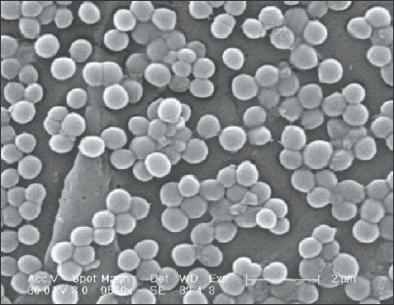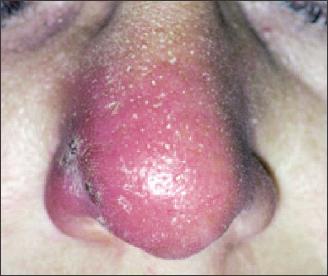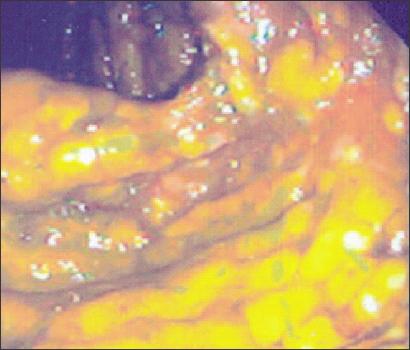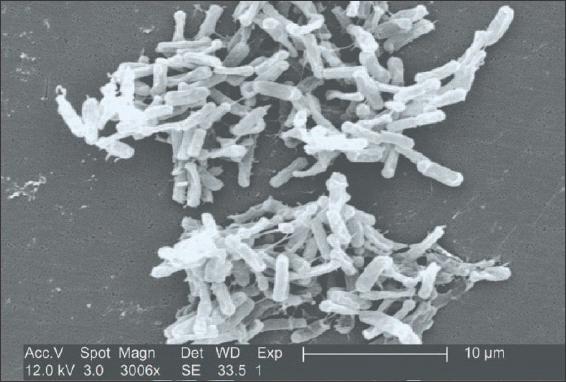- Clinical Technology
- Adult Immunization
- Hepatology
- Pediatric Immunization
- Screening
- Psychiatry
- Allergy
- Women's Health
- Cardiology
- Pediatrics
- Dermatology
- Endocrinology
- Pain Management
- Gastroenterology
- Infectious Disease
- Obesity Medicine
- Rheumatology
- Nephrology
- Neurology
- Pulmonology
Meeting the Challenge of New Infectious Scourges: MRSA, C difficile BI/NAP1, and New Strains of STD Pathogens
Within the past decade, the incidence of methicillin-resistantStaphylococcus aureus (MRSA) has increased significantly,spreading from the hospital to the community setting. Patientswith skin infections whose condition is stable should be treatedwith antibiotic therapy as well as with incision and drainage,whereas patients with severe disease require hospitalizationand intravenous therapy. In addition to community-acquiredMRSA, a new strain of Clostridium difficile, BI/NAP1, has led toclinical challenges in infectious diseases medicine. The strainhas been associated with recurrent infection; more severe diseasethat mandates urgent colectomy; and dramatically highermortality in vulnerable populations, such as older adults. Oralvancomycin, rather than metronidazole, may be slightly moreeffective in patients with severe disease. Also, new strains of Chlamydia and Treponema are posing potential complications tothe treatment of sexually transmitted diseases such that cliniciansneed to be judicious in selecting antibiotic therapy in accordancewith factors related to geography and patient population.[Infect Med. 2008;25:421-424]
Whereas infectious diseases overall remain major threats to health in the developing world, infection control in wealthier, more technologically advanced countries generally has been handled with ease, thanks to a broad armamentarium of antibiotic agents. The complacency that has set in, however, has been shaken in recent years by the emergence of new, often antibiotic-resistant strains of bacteria. Among these threats are methicillin- resistant Staphylococcus aureus (MRSA) and Clostridium difficile BI/NAP1.
MRSA
Beginning in 2001, the prevalence of skin and soft tissue infections caused by MRSA greatly increased.1 Unlike previous MRSA infections, these infections were more severe and recurrent and affected persons who were not previously ill and who had not recently been in a hospital or nursing home (eg, active and healthy children, 2 soldiers,3 athletes4).
A thorough analysis of the MRSA strains showed that community acquired MRSA (CA-MRSA) strains are closely related to one another and are unlike the traditional MRSA isolates found in hospitalized patients (Figure 1). The most common CA-MRSA strain, USA-300, contains a significant number of toxin genes as well as an adherence property previously associated with other species of Staphylococcus (including the common skin bacterium Staphylococcus epidermidis).5 This adherence property might account for the ease of transmission from person to person; meanwhile, the presence of the toxins may explain the severity of illness caused by CA-MRSA, including systemic illness that can lead to pneumonia or death.

Figure 1 -
Thisscanning electronmicrograph showsnumerous clumps ofmethicillin-resistant
Staphylococcusaureus
organisms(magnification X9560).(Courtesy of theCenters for DiseaseControl and Prevention/Janice Carr.)
Epidemiological analysis showed that the acquisition of CA-MRSA is related to both exposure opportunities and diminution of host protection. Exposure to the organism was found among close, frequent contacts living in various environments, such as dormitories, prisons, and military barracks. Transmission may have been abetted by poor hygiene (eg, the sharing of towels and personal grooming supplies that are colonized with these adherent strains).
Reduced host defenses are a more complex risk factor. However, there is a striking association between previous antibiotic therapy and new infections with MRSA. In an outbreak of CA-MRSA skin infections among professional football players, the mean number of antibiotic prescriptions was 2.6 per year.4 In military recruits who were colonized on entry into boot camp, any antibiotic use during the previous 6 months was a risk factor for nasal colonization with CA-MRSA (P = .03).3 Nasal colonization resolved within weeks; however, subsequent infections developed in 38% of those with nasal colonization, compared with 3% of those without colonization.
The difference between classic S aureus infection and MRSA infection can be subtle. MRSA strains have a propensity to lead to deeper soft tissue infections and pneumonia. When confined to the skin, MRSA infections can be difficult to distinguish from classic S aureus infections (Figure 2). Unless there is strong evidence to the contrary, MRSA should be considered in cases in which antibiotic treatment is needed. When coverage for MRSA is not possible, close follow-up should be arranged so that treatment can be changed if the patient's condition worsens.

Figure 2 -
Infection withcommunity-acquiredmethicillin-resistantStaphylococcus aureuswas suspected whennasal cellulitis in this39-year-old woman failedto respond to oral ciprofloxacin.Culture and sensitivitystudies of nasal drainageconfirmed the clinicalsuspicion. (Courtesy ofRobert P. Blereau, MD.)
In the past, the classic clinical picture of a staphylococcal infection was an acutely ill patient with a localized skin lesion, such as an abscess, or a more diffuse skin infection, such as cellulitis. This infection would respond to oral antibiotics and drainage of any pus collections. In fact, incision and drainage was thought to constitute adequate management of an S aureus skin abscess.6 Incision and drainage is still an important component of treatment, although close follow-up is needed to assess the response to drainage and to look for recurrence. Patients who have lesions that are identified early and treated medically or who have small lesions that are treated expectantly can often avoid incision and drainage.
In addition to incision and drainage, oral antibiotic therapy is recommended for stable patients. Hospitalization with intravenous antibiotic therapy is recommended for patients whose condition is unstable or who are unlikely to adhere to an oral regimen. For oral therapy, the usual choices include trimethoprim/ sulfamethoxazole, clindamycin, doxycycline or minocycline (sometimes with rifampin), and linezolid.
C difficile
Antibiotic-associated diarrhea and colitis have long been major concerns for clinicians who care for hospitalized patients (Figure 3). Studies from the mid-1980s onward have shown that the most severe kinds of hospital acquired colitis are related to C difficile colonization (Figure 4). The presence of this bacterium is almost uniformly associated with previous antibiotic therapy, without which the risk of C difficile colitis is very low. Antibiotics that suppress the normal anaerobic flora in the gut-without also suppressing C difficile-predispose patients to C difficile-associated diarrhea (CDAD). Such antibiotics include clindamycin and various penicillins and cephalosporins.

Figure 3 -
The diffuseyellowish pseudomembranousplaques seenin this colonoscopyview are characteristicof colitis caused byinfection with
Clostridium difficile.
This patient was apreviously healthyyoung man in whomsevere C difficiledisease developedwhile he was takingantibiotics for anacute exacerbation ofchronic sinusitis.(Courtesy of ManishAmin, DO, and NavinM. Amin, MD.)

Figure 4 -
This micrograph shows Clostridium difficile in a stool sample culture, which wasobtained by using a 0.1-?m filter (magnification X3006). (Courtesy of the Centers for DiseaseControl and Prevention/Janice Carr.)
In 2000, the incidence of CDAD surged. This increase was worrisome because it was accompanied by higher than usual mortality, and cases occurred in patients who had taken antibiotics not typically associated with CDAD or who had not received antibiotics. These new cases were also difficult to treat effectively without recurrence. Furthermore, the severity of the disease was associated with a greater need for urgent colectomy7 and with dramatically higher mortality in vulnerable populations, such as older adults.
A new strain of C difficile, BI/ NAP1, was detected by in vitro testing. Most isolates of this strain are highly fluoroquinolone-resistant, which may account for the high risk of CDAD in patients who receive this class of drug. Tests showed extremely high levels of the usual C difficile toxins as a result of derepression of the toxin gene as well as a binary toxin gene complex that had previously rarely been found in C difficile. The role of the binary toxin has not been completely illuminated. The isolates of this BI/NAP1 strain have been found predominantly in Canada and the United States (in the northeast and southeast quadrants and on the West Coast).8 The precise origin of the BI/NAP1 strain is unknown. The clinical manifestations of patients infected with this new strain overlap with the classic symptoms (fever, diarrhea, abdominal pain) and laboratory test results (increased white blood cell count, positive results on C difficile toxin assays) of patients with C difficile infection.
Treatment of infection with the BI/NAP1 strain is the same as that of classic C difficile infection, but clearly there is a need for vigilance and an early change of therapy (possibly including surgery) for slow responders. Although oral metronidazole alone has been the mainstay of treatment for C difficile infection, oral vancomycin may be slightly more effective for patients with severe disease.9 The treatment of patients who cannot tolerate oral medications is difficult; for these patients, vancomycin enemas have been suggested.
Recommended preventive strategies include:
- Limiting antibiotic use (especially clindamycin, cephalosporins, and fluoroquinolones).
- Patient isolation.
- Zealous hand hygiene, preferably hand washing, because alcohol based hand hygiene products are less effective against spore-forming organisms, such as clostridia.
- Environmental cleaning.
New strains of STD pathogens
Meningococcal resistance to penicillin is still very rare, and pneumococcal resistance to penicillin is not yet a critical clinical problem for patients with respiratory tract infections. However, unexpected resistance can result from unusual selection pressures.
A Dutch study reported an outbreak of lymphogranuloma venereum, a chlamydial sexually transmitted disease (STD), that occurred mostly in HIV-1-infected men who had sex with men.10 Eventually, other cases were found outside the initial Rotterdam cohort, and some have appeared in the United States. Azithromycin is preferred to treat lymphogranuloma venereum and sometimes even syphilis; however, this drug has had substantial exposure among men with advanced HIV-1 infection because it is a preventive agent for Mycobacterium avium complex (MAC) infection.
Astrain of Treponema pallidum that is resistant to macrolides (including azithromycin) has been identified, and the resistance phenotype is thought to be the result of a specific, new mutation in the 23S ribosomal RNA gene.11 Researchers theorize that this ribosomal mutation is more prevalent in populations that are heavily exposed to macrolides (for management of pneumonia, MAC infection prophylaxis, and chlamydial genital infection) and that are at high risk for syphilis. Variants of this azithromycin-resistant strain have been found on the West Coast of the United States, in Maryland, and in Ireland. Azithromycin should be used to treat syphilis only in areas in which it is likely to be effective (based on regional resistance data) and in patients who can be monitored for possible failure.
Conclusion
When it comes to infections, nature does not pull her punches but instead responds to our successes in treatment with new and surprising challenges. A reflexive approach that involves aggressive use of empirical antibiotics for persons with viral or trivial bacterial infection seems harmless in the short run, but it has likely contributed strongly to our current predicament with highly resistant bacteria.
Luckily, the formula for success in treating bacterial infections already exists if we are willing to stick with it. We must educate patients to not expect to receive antibiotics for every cough or rash. We must remind one another to use bacterial cultures wisely so that we can learn about the flora in our communities and be apprised of changes, which are ongoing. We should strive to reduce the transfer of resistant bacteria in the community and in hospital settings in efforts to interrupt the chain of transmission. Finally, we need to lobby both industry and government to prioritize the development of new antibiotics to handle the current troublemakers as well as the inevitable emergence and spread of resistant bacteria that will bedevil doctors and patients in years to come.
References:
- Hawkes M, Barton M, Conly J, et al. Community-associated MRSA: superbug at our doorstep. CMAJ. 2007;176:54-56.
- Herold B, Immergluck LC, Maranan MC, et al. Community-acquired methicillin-resistant Staphylococcus aureus in children with no identified predisposing risk. JAMA. 1998;279:593-598.
- Ellis MW, Hospenthal DR, Dooley DP, et al. Natural history of community-acquired methicillin-resistant Staphylococcus aureus colonization and infection in soldiers. Clin Infect Dis.2004;39:971-979.
- Kazakova SV, Hageman JC, Matava M, et al. A clone of methicillin-resistant Staphylococcus aureus among professional football players. N Engl J Med. 2005;352:468-475.
- Liera JL, Levy RC. Treatment of cutaneous abscess:a double-blind clinical study. Ann Emerg Med. 1985;14:15-19.
- Holden MT, Feil EJ, Lindsay JA, et al. Complete genomes of two clinical Staphylococcus aureus strains: evidence for the rapid evolution of virulence and drug resistance. Proc Natl Acad Sci U S A. 2004;101:9786-9791.
- Loo VG, Poirier L, Miller MA, et al. Apredominantly clonal multi-institutional outbreak of Clostridium difficileâassociated diarrhea with high morbidity and mortality. N Engl J Med. 2005;353:2442-2449.
- McDonald LC, Killgore GE, Thompson A, et al. An epidemic, toxin gene-variant strain of Clostridium difficile. N Engl J Med. 2005;353:2433-2441.
- Zar FA, Bakkanagari SR, Moorthi KM, Davis MB. Acomparison of vancomycin and metronidazole for the treatment of Clostridium difficile-associated diarrhea, stratified by disease severity. Clin Infect Dis. 2007;45:302-307.
- Nieuwenhuis RF, Ossewaarde JM, Götz HM, et al. Resurgence of lymphogranuloma venereum in Western Europe: an outbreak of Chlamydia trachomatis serovar L2 proctitis in The Netherlands among men who have sex with men. Clin Infect Dis. 2004;39:996-1003.
- Lukehart SA, Godornes C, Molini BJ, et al. Macrolide resistance in Treponema pallidum in the United States and Ireland. N Engl J ed. 2004;351:154-158.
